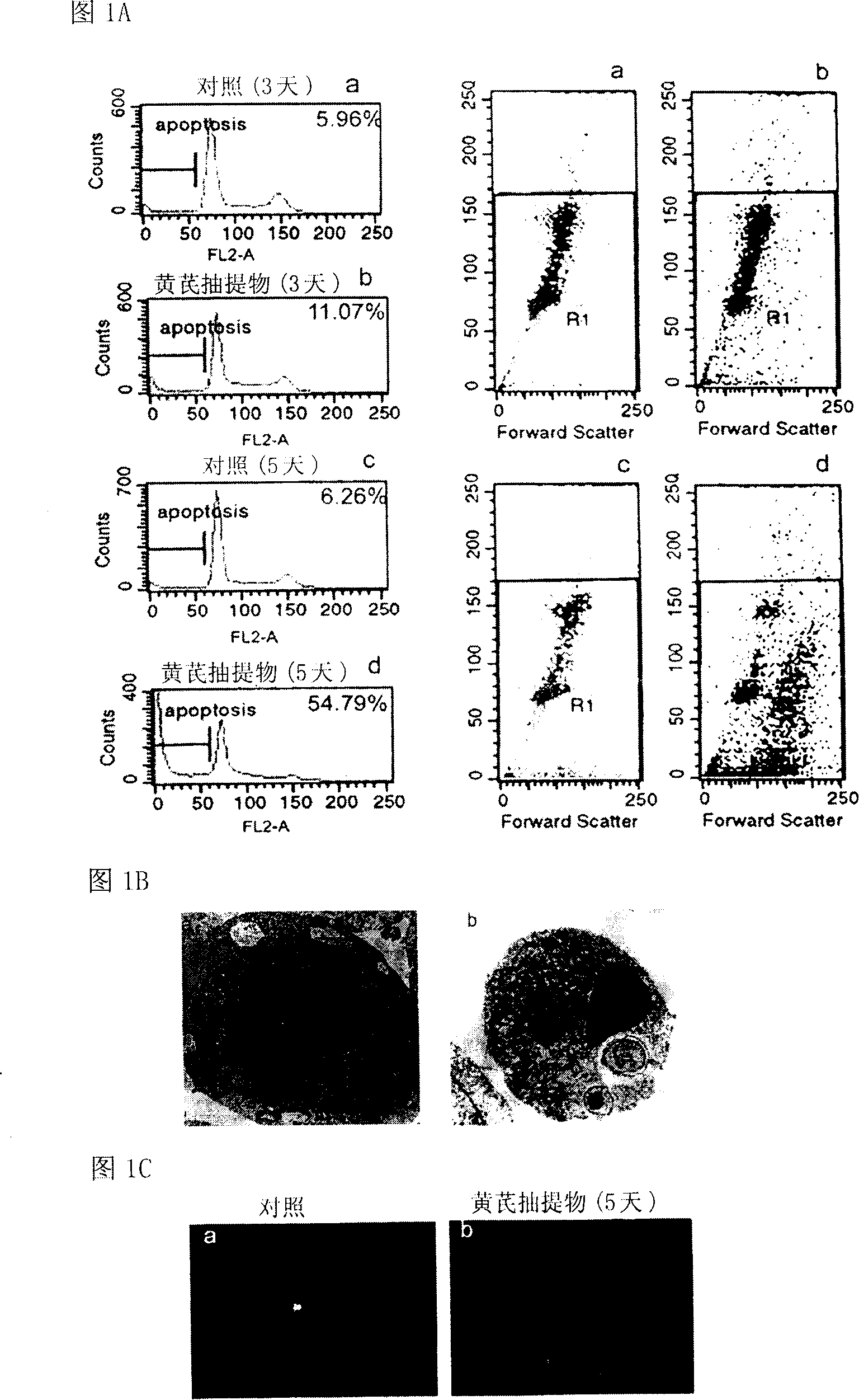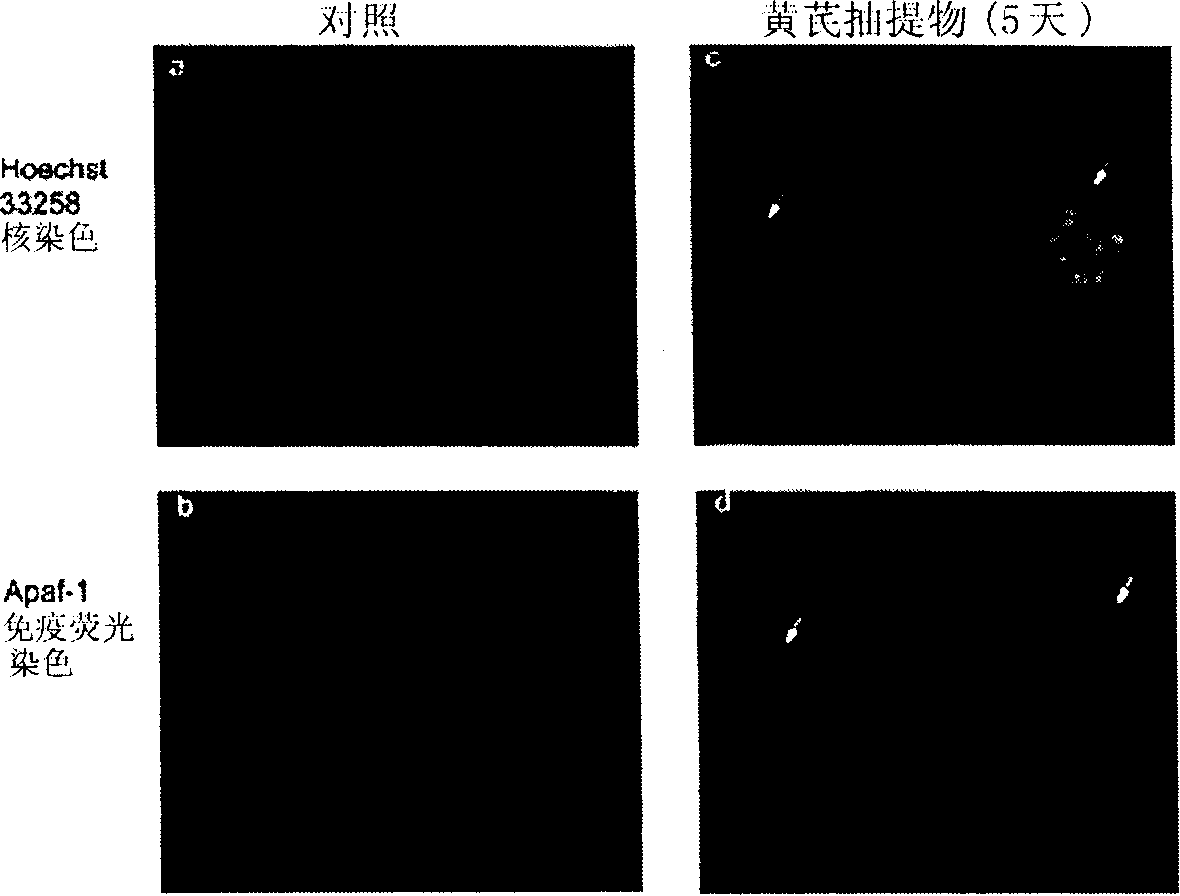Medicine for inducing cells to die, and its application
A cell and drug technology, applied in the field of biomedicine, can solve problems such as unclear function and mechanism of action, and achieve a significant effect of drug efficacy
- Summary
- Abstract
- Description
- Claims
- Application Information
AI Technical Summary
Problems solved by technology
Method used
Image
Examples
Embodiment 1
[0064] Example 1 Astragalus Induces HEL Cell Apoptosis Experiment
[0065] Cell culture and induction of apoptosis: HEL and K562 cells (purchased from the Cell Bank of Shanghai Institutes for Biological Sciences, Chinese Academy of Sciences) were used in RPMI-1640 medium (GIBCO-BRL) containing 10% calf serum at 37°C with 5% CO 2 cultured in a cell culture incubator. Boil Astragalus (produced in Inner Mongolia) with distilled water for 60-90 minutes, remove lumps, and filter to obtain Astragalus solution. The astragalus solution was centrifuged at low temperature at high speed, and the supernatant was freeze-dried to obtain the astragalus extract, which was stored at -20°C for later use. During induction, add astragalus extract at 4.5 mg / ml to the cultured HEL cells and culture for 3-5 days.
[0066] Flow cytometry analysis: The HEL cells induced and uninduced by Astragalus extract were collected by centrifugation and resuspended in citrate solution. Cell suspensions were fr...
Embodiment 2
[0069] Example 2 Astragalus Induces Up-regulation of Apaf-1 Expression in HEL Cells
[0070] Nucleus staining and morphological observation: HEL cells were collected and fixed, resuspended in Hoechst 33258 solution for staining, and after smearing, observed with a fluorescent microscope and photographed.
[0071] Immunofluorescence staining: The HEL cells induced and uninduced by Astragalus extract were collected by centrifugation, fixed and blocked for 45 minutes, and the primary antibody (Apaf-1 polyclonal antibody was purchased from Santa Cruz Company, sc-8339) was added to react for 30 minutes After washing, Rhodamine-labeled secondary antibody (anti-rabbit, purchased from Rockland Company) was added to react for 30 minutes. Fluorescence microscope observation after washing. After Astragalus induced HEL cells, it promoted the expression of apoptosis protease-activating factor 1 (Apoptotic protease-acting factor 1, APAF1) in the cells and the formation of apoptotic bodies ...
Embodiment 3
[0073] Example 3 Astragalus induced the activity upregulation of caspase-3 in HEL cells
[0074] a) Immunofluorescence staining: The HEL cells induced and uninduced by Astragalus extract were collected by centrifugation, fixed and blocked for 45 minutes, and reacted for 30 minutes with primary antibody (Caspase 3 monoclonal antibody purchased from Santa Cruz Company), washed and then FITC-labeled secondary antibody (anti-mouse, purchased from Rockland Company) was added to react for 30 minutes. Fluorescence microscope observation after washing. After Astragalus induced HEL cells, the activity of protease-3 (Caspase-3) was activated. The results of immunofluorescence analysis showed that after induction of HEL cells with Astragalus, in apoptotic cells, Caspase-3 was activated and stained positively (green, gray in 3a in the attached figure), while in non-apoptotic cells In apoptotic HEL cells, protease-3 activity was negatively stained ( image 3 ).
[0075] The above resul...
PUM
 Login to View More
Login to View More Abstract
Description
Claims
Application Information
 Login to View More
Login to View More - R&D
- Intellectual Property
- Life Sciences
- Materials
- Tech Scout
- Unparalleled Data Quality
- Higher Quality Content
- 60% Fewer Hallucinations
Browse by: Latest US Patents, China's latest patents, Technical Efficacy Thesaurus, Application Domain, Technology Topic, Popular Technical Reports.
© 2025 PatSnap. All rights reserved.Legal|Privacy policy|Modern Slavery Act Transparency Statement|Sitemap|About US| Contact US: help@patsnap.com



